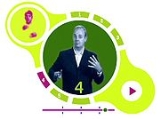
Sign language media
Encyclopedia
Sign language media are media
based on a media system for sign languages. Interfaces
in sign language media are built on the complex grammar structure of sign languages. Generally media are built for spoken languages or written language
s. Unfortunately those media are not compatible with sign languages.
Sign language media have specific characteristics:
Mass media
Mass media refers collectively to all media technologies which are intended to reach a large audience via mass communication. Broadcast media transmit their information electronically and comprise of television, film and radio, movies, CDs, DVDs and some other gadgets like cameras or video consoles...
based on a media system for sign languages. Interfaces
User interface
The user interface, in the industrial design field of human–machine interaction, is the space where interaction between humans and machines occurs. The goal of interaction between a human and a machine at the user interface is effective operation and control of the machine, and feedback from the...
in sign language media are built on the complex grammar structure of sign languages. Generally media are built for spoken languages or written language
Written language
A written language is the representation of a language by means of a writing system. Written language is an invention in that it must be taught to children, who will instinctively learn or create spoken or gestural languages....
s. Unfortunately those media are not compatible with sign languages.
Sign language media have specific characteristics:
- Sound is absent, or on very low frequencies (bass).
- No, or very little, text is used.
- A specific camera frame for close-upClose-upIn filmmaking, television production, still photography and the comic strip medium a close-up tightly frames a person or an object. Close-ups are one of the standard shots used regularly with medium shots and long shots . Close-ups display the most detail, but they do not include the broader scene...
s.
Milestones
- Analog era:
- FilmFilmA film, also called a movie or motion picture, is a series of still or moving images. It is produced by recording photographic images with cameras, or by creating images using animation techniques or visual effects...
- Sign language media is born. The first sign language film is created in 1907. - VideoVideoVideo is the technology of electronically capturing, recording, processing, storing, transmitting, and reconstructing a sequence of still images representing scenes in motion.- History :...
- Sign language magazines on video are distributed.
- Film
- Digital era:
- Digital videoDigital videoDigital video is a type of digital recording system that works by using a digital rather than an analog video signal.The terms camera, video camera, and camcorder are used interchangeably in this article.- History :...
and software - Sign language interfaces are created to browse content. - World wide webWorld Wide WebThe World Wide Web is a system of interlinked hypertext documents accessed via the Internet...
- Information in sign language becomes available for everyone. - The videophoneVideophoneA videophone is a telephone with a video screen, and is capable of full duplex video and audio transmissions for communication between people in real-time...
and webcamWebcamA webcam is a video camera that feeds its images in real time to a computer or computer network, often via USB, ethernet, or Wi-Fi.Their most popular use is the establishment of video links, permitting computers to act as videophones or videoconference stations. This common use as a video camera...
- Sign language telecommunication becomes possible. - Mobile videotelephony - UMTS provides support for sign language telecommunications.
- Vlogs - Sign language newssites start booming with the protest against Jane FernandesJane FernandesJane Kelleher Fernandes is a deaf educator and is the Provost and Vice Chancellor for Academic Affairs at the University of North Carolina Asheville as of July 1, 2008. Dr. Fernandes was the former President Designate of Gallaudet University...
.
- Digital video

